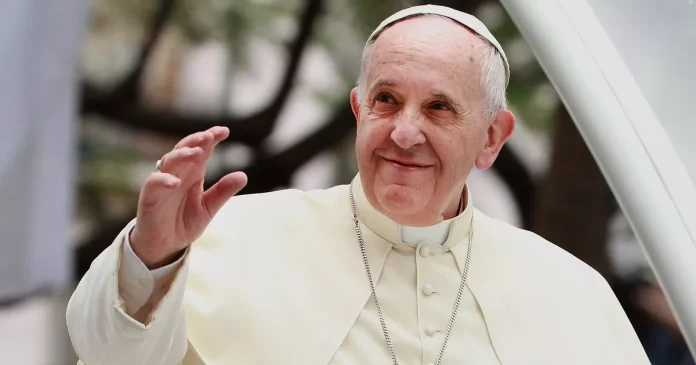Pope Francis passed away on Monday, April 21 at his home in the Vatican’s Casa Santa Marta at the age of 88.
This was a significant date as it was Easter Monday and his death was announced less than 24 hours after he gave an Easter Sunday address in front of thousands of worshipers in St Peter’s Square, Vatican City, Rome. The Pope was the head of the Catholic Church and sovereign of the Vatican City State from 2013 until his death on Monday.
He died following a stroke and subsequent irreversible heart failure, the Vatican announced. Some people might think after a Pope dies there is a funeral, a period of mourning and then the next leader is elected but @CultureExploreX has shared that there is much more to it.
In a post on X the user wrote: “Most people think a pope dies, and that’s it. Funeral, mourning, next man up. But what actually happens behind Vatican walls? It’s one of the oldest and most secretive rituals in the world. And it just got triggered.”
They added: “Pope Francis is gone. He passed away on Easter Monday. And now, the Vatican enters a phase it hasn’t faced in 20 years—The Papal Interregnum.
“Here’s what’s really going on… and what happens next.” The Papal Interregnum is the period between the death or resignation of a Pope and the election of his successor.
When a Pope dies, it is tradition for the Papal Apartments to be sealed. Vatican News reported that seals were placed on the papal apartment on the third floor of the Apostolic Palace and on the apartment on the second floor of the Casa Santa Marta, where Pope Francis lived.
After the death or resignation of a Pope, a cardinal is put in charge and he becomes the ‘camerlengo’, the man who temporarily runs the Church. It is currently the Irish-American Kevin Farrell.
The ceremony confirming the death and the placement of the body in the coffin was held on Monday evening at 8pm in the chapel located on the ground floor of the late Pope’s residence at Casa Santa Marta. During this ceremony, the declaration of death was read aloud and the act was validated by Cardinal Farrell, according to Vatican News.
The Pope’s coffin is now inside St Peter’s Basilica, having been moved from his residence in the Vatican. It will remain lying in state there until the funeral on Saturday, April 26.
Culture Explorer X added: “Soon, the lines will stretch for miles. Just like they did in 2005 for John Paul II. It won’t just be Catholics showing up.” The general public is now able able to visit St Peter’s Basilica to file past Pope Francis’ coffin to pay their respects and more than 20,000 people have gathered at St Peter’s Square, BBC News reported.
Culture Explore X continued: “His funeral will follow a 9-day mourning period called the Novendiales. By Church law, he must be buried between Day 4 and Day 6.
“Francis asked to be buried underground, no gold, no fanfare. Just ‘Franciscus’ carved on the stone. That’s it.”
The Catholic Company magazine further explained: “The funeral is held in St. Peter’s Square, led by the dean of the College of Cardinals, with thousands of mourners in attendance. Most popes are interred in the Vatican Grottoes beneath St. Peter’s Basilica, though some have chosen different resting places.
“Pope Francis, for example, has expressed his wish to be buried at Santa Maria Maggiore in Rome. Traditionally, popes have been buried in three nested coffins—one of cypress, one of zinc, and one of elm. However, Francis has opted for a simpler wooden and zinc coffin.”
Two to three weeks after the funeral, the process of electing a new Pope begins and this is known as the conclave, as per the Catholic Company. Eligible cardinals (those under 80-years-old) gather in the Sistine Chapel to vote and the election follows three four steps, as outlined by the magazine.
The chapel is sealed off, ensuring secrecy and cardinals cast their votes in rounds, with a two-thirds majority required to elect a new pope. If no candidate is chosen, ballots are burned with chemicals to produce black smoke, signalling an inconclusive vote and when a new pope is elected, white smoke rises, announcing the decision to the world.
The Catholic Company adds that the newly elected pope chooses a name and steps onto the balcony of St. Peter’s Basilica, where the world hears the “famous announcement”: Habemus Papam! – “We have a pope!”
At Reach and across our entities we and our partners use information collected through cookies and other identifiers from your device to improve experience on our site, analyse how it is used and to show personalised advertising. You can opt out of the sale or sharing of your data, at any time clicking the “Do Not Sell or Share my Data” button at the bottom of the webpage. Please note that your preferences are browser specific. Use of our website and any of our services represents your acceptance of the use of cookies and consent to the practices described in our Privacy Notice and Cookie Notice.


